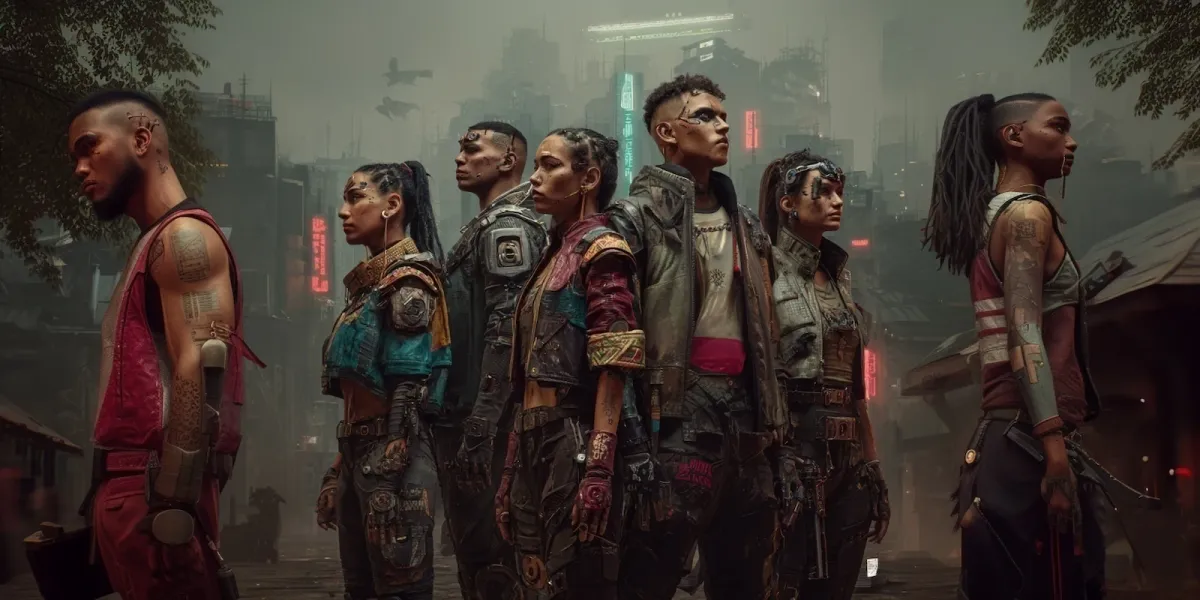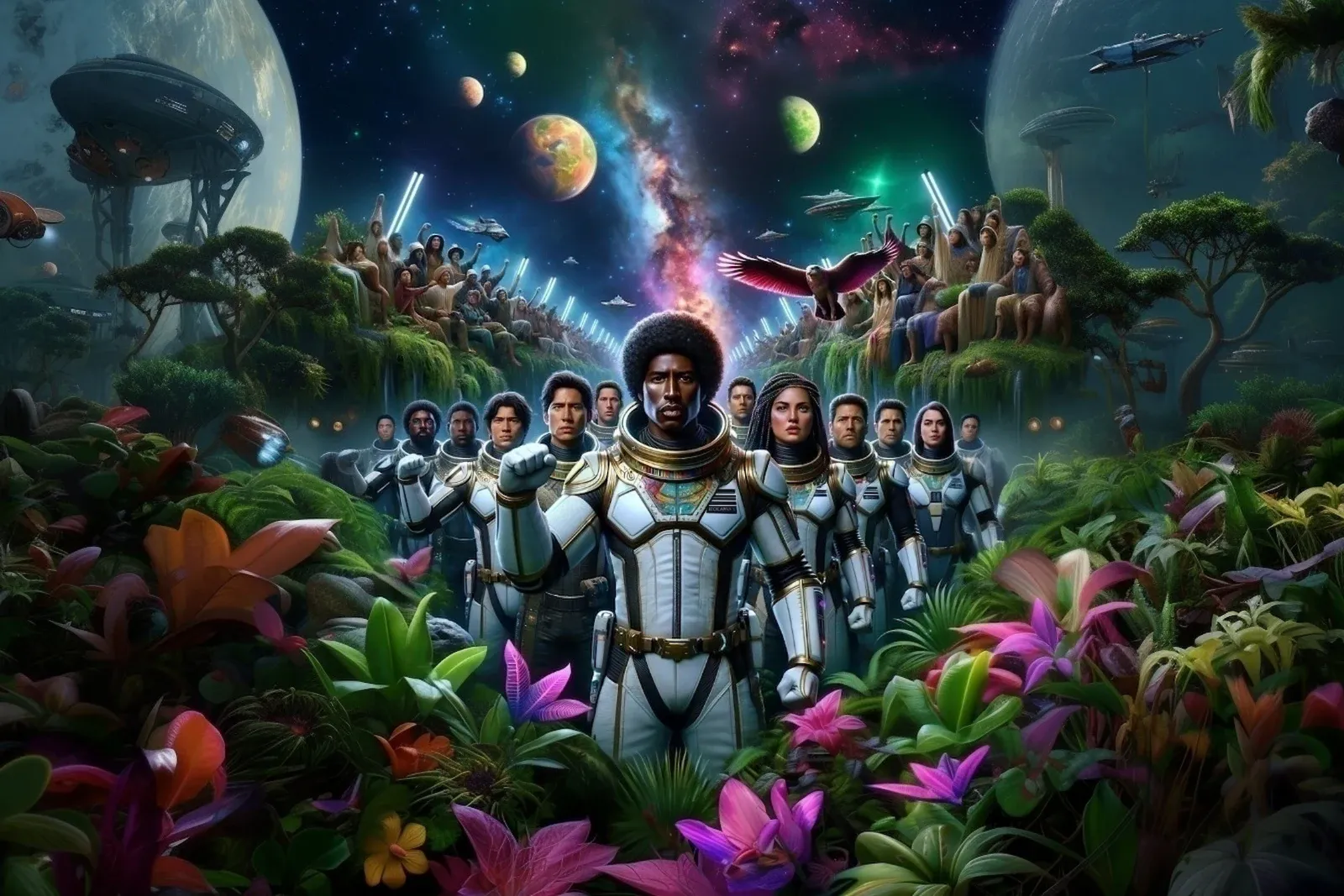Latinos in Science Fiction

I am seeking scholars, researchers, and writers interested in contributing to a new space dedicated to Latin American science fiction and Latinos in global sci-fi. Too often, this work is scattered, overlooked, or miscategorized — I want to create a hub where it can be gathered, updated, and amplified.
If you are a scholar, researcher, or writer passionate about these conversations, I’d love to connect and collaborate.
Who Gets to Imagine the Future?
Science fiction has long been a genre of possibility — of terraforming planets, time traveling across civilizations, and building worlds out of dreams and nightmares. But for a genre so obsessed with the future, it’s striking how narrow-minded that future can be.
Latinos — in all our complexity — have long been missing from the imagined tomorrows that dominate bookshelves, streaming platforms, and classrooms. Not because we don’t belong there, and certainly not because we haven’t contributed, but because science fiction has been a canon shaped by whiteness, built on stories that either exoticize us, erase us, or never write us in to begin with.
Recent scholarship confirms this pattern: Latin American and Latinx writers have long contributed to science fiction, but their presence in the canon remains fragmented and under-recognized (Cortés Correa 2022; Goodwin 2021; Dalton 2022).
So the question isn’t just: where are the Latinos in science fiction? It’s also: why are they not being read?
Before Bradbury, Before Asimov — There Was de Rivas
Let's start at the beginning — or before what most consider the beginning. In 1775, a Mexican friar named Manuel Antonio de Rivas wrote Syzygies and Lunar Quadratures, a story about a heretic traveling to the moon and meeting alien civilizations (Ferreira, 2011). This may be the first science fiction story written in the Americas — and yet it's absent from most histories of the genre. Scholars such as Dalton (2022) and López-Pellisa & Kurlat Ares (2020) highlight the importance of recovering these overlooked texts, showing that Latin American science fiction has deep roots extending back to the 18th and 19th centuries.
From the 19th century on, writers like Eduardo Ladislao Holmberg (Viaje maravilloso del Señor Nic-Nac al planeta Marte, 1875-76), Leopoldo Lugones, and Horacio Quiroga helped shape a distinct Latin American speculative tradition. Often miscategorized as magical realists, they were in fact speculating about science, power, and the future in ways that anticipated — and in some ways surpassed — their Anglo counterparts (Cosmos Latinos, 2003).
Other key authors from this era include Angélica Gorodischer (Kalpa Imperial), Adolfo Bioy Casares (The Invention of Morel), and Daína Chaviano (Cuba). Cuban author Yoss (A Planet for Rent, Super Extra Grande) helped define modern Cuban cyberpunk.
Anthologies like Cosmos Latinos and Three Messages and a Warning (Small Beer Press) have made these voices more accessible to English-language readers.
Recent scholarship has expanded the Latin American sci-fi timeline even further, identifying early speculative texts like México en el año 1970 (1844), Páginas da história do Brasil escripta no anno de 2000 (1868–72), and Viaje maravilloso del Señor Nic-Nac al planeta Marte (1875–76), predating the genre's formal birth in the United States (SFS Issue 103, 2007).
Latinas Have Been Writing the Future All Along
Women have long imagined alternate futures and haunted presents from a Latin American perspective.
Writers like María Luisa Bombal (La última niebla, 1935), Elena Garro (Los recuerdos del porvenir, 1963), Rosario Castellanos, and Silvina Ocampo created stories that bent time, reimagined gender, and questioned reality itself — core principles of speculative fiction. More recently, authors like Samanta Schweblin (Distancia de rescate, 2014), Agustina Bazterrica (Cadáver exquisito, 2017), and Mariana Enriquez (Nuestra parte de noche, 2019) have made international waves with feminist horror, body dystopias, and psychological sci-fi (Ascanio, 2020).
As Cortés Correa (2022) notes, Latin American women writing science fiction often faced "triple marginalization" — excluded not only for their gender and genre, but also for their regional position within global literature. Recent feminist recovery efforts are beginning to shift this visibility, placing figures like Bombal, Garro, and Castellanos within speculative traditions rather than relegating them to the category of "magical realism."
And still, they're often left out of genre conversations. Not because their work doesn't qualify — but because genre borders have always been policed by institutional gatekeepers: award committees, major publishers, academic syllabi, and English-language translation markets that prioritize established Anglo-American voices.
Latinx Futurism: Dreaming Diaspora into the Stars
In the United States, Latinx writers are forging a genre of their own: Latinx Futurism. These works merge sci-fi with migration, colonial memory, spiritual traditions, and resistance.
The "alien" has become a central metaphor. As Goodwin (2021) shows, Latinx science fiction writers in the United States have reclaimed the trope of the extraterrestrial to articulate migrant subjectivities — transforming the alien from a xenophobic figure into one of cultural preservation and resistance.
Gloria Anzaldúa, in Light in the Dark (2015), fused speculative elements with queer indigeneity and mestiza consciousness (Vado, 2019).
Junot Díaz has explored sci-fi through stories like "Monstro" (2012). In film, Alex Rivera's Sleep Dealer (2008) envisioned a near-future Mexico where workers plug into machines to labor remotely across the border (González, 2013).
Writers like Carmen Boullosa (Cielos de la Tierra, 1997), Edmundo Paz Soldán (Sueños digitales, 2000), and Bernardo Fernández (BEF) explore cyberpunk, ecological collapse, time travel, and political dystopia across Latin America (Ginway & Brown, 2012). In Turing's Delirium (El delirio de Turing, 2003), Paz Soldán even connects Borges and Philip K. Dick into a shared sci-fi lineage.
The Mundos Alternos exhibition (2017-2018) showcased speculative work by Latinx and Latin American artists across media. Even The New York Times acknowledged the Latin American sci-fi boom in 2023, noting the surge of women and queer authors challenging traditional literary forms. The Harvard Political Review also spotlighted the genre's power to dismantle colonial narratives.
Meanwhile, readers on Reddit have been curating Latin American sci-fi reading lists, sharing titles and insights in threads like this one and this earlier thread.
Evidence of Change: The Futures Are Cracking Open
We're starting to break through.
Books like Mexican Gothic by Silvia Moreno-Garcia (2020) and Cemetery Boys by Aiden Thomas (2020) became bestsellers. And Latinx speculative writers are earning more attention in awards, university classrooms, and publishing catalogs.
These works echo what comparative scholars (Bell 2022; Ginway & Brown 2012) identify as recurring motifs in Latin American science fiction: resistance, hybridity, and altered bodies that reflect colonial legacies and futuristic possibilities.
In media, our faces are appearing in the big franchises:
- Pedro Pascal as the lead in The Mandalorian (2019-present)
- Diego Luna anchoring Andor (2022-present)
- Isabela Merced starring in Alien: Romulus (2024)
But the real shift is deeper. Across Latin America:
- The Eternaut (El Eternauta, 2025, Netflix) adapted a legendary Argentine sci-fi comic and premiered globally on April 30, 2025, becoming one of the platform's top non-English titles.
- Aire: Just Breathe (2024, Dominican Republic) imagined a post-apocalyptic AI future.
- Omniscient (Onisciente, 2020, Brazil) explored a surveillance society.
- The Shelter (El Refugio, 2021, Argentina) became one of the first premium sci-fi series from Latin America.
- The Ballad of Tita and the Machines (2023), a short film, tackled AI and labor through a Latinx lens (LA Times, 2023).
These aren't one-offs. Institutions are starting to recognize the movement. The Museum of the Moving Image's Uchronias and Dystopian Futures series (2023), the Library of Congress's Latinx Futurism guide, and academic publications like Science Fiction Studies are all charting this rise.
That visibility matters. But let's be clear: being cast in a role isn't the same as having the power to create the world. The revolution is not only about who gets on the spaceship, but who builds it — and Latinx voices must be the architects.
Gatekeeping Still Shapes the Canon
Despite centuries of work, Latinx and Latin American sci-fi often gets boxed out.
The most recent Lee & Low Diversity Baseline Survey (2023) found that only 4.6% of publishing industry employees identify as Hispanic/Latino/Mexican — a concerning decrease from 6% in both 2015 and 2019. This represents not just underrepresentation but actual loss of ground in an industry where Latinos now comprise approximately 20% of the U.S. population.
Many of our writers are funneled into "magical realism" or "immigrant narrative" categories. As if we can't dream about artificial intelligence, other planets, or temporal collapse.
The truth is: we've always done that. And we're still doing it — often without permission, funding, or institutional support.
Scholars also note ongoing gaps: while Mexico, Argentina, Brazil, and Cuba dominate the field's visibility, Central America (beyond El Salvador) and the Caribbean (beyond Cuba) remain underexplored (Morrison 2022). Translation and reception studies are especially lacking, signaling an urgent frontier for both scholarship and creative production.
Other Futurisms: Decolonizing Tomorrow Beyond Latinx Space
While Latinx Futurism powerfully reclaims science fiction from the margins of empire, it is only one expression of a larger, transnational, intersectional movement of speculative resistance. Around the world, historically excluded communities have long used speculative fiction not merely to demand visibility, but to transform the terms of futurity — imagining not just new people in the spaceship, but entirely new ways of building the ship.
Afrofuturism, Indigenous Futurisms, Queer/Trans Futurisms, and Asian Futurisms expand the sci-fi canon. These movements share key traits: they are often rooted in ancestral memory, trauma, non-linear time, and hybrid epistemologies. They are also frequently overlooked, tokenized, or misread within mainstream genre discourse — and even within Latinx literary spaces.
Afrofuturism: Blackness Beyond Time
“Black people live the estrangement science fiction talks about every day.” — Octavia Butler
Afrofuturism is not just a genre — it's a methodology of survival. It blends science fiction, fantasy, philosophy, history, and the arts to explore the Black experience through a futuristic lens. Crucially, it links past oppression with speculative futures, challenging linear notions of progress and Eurocentric technology.
From the cosmic jazz of Sun Ra to the posthuman android visions of Janelle Monáe, Afrofuturism offers radical counter-worlds where Blackness is central to imagining tomorrow.
📚 Notable Works & Thinkers:
- Octavia Butler – Parable of the Sower, Kindred
- Rita Indiana (Dominican Republic) – La mucama de Omicunlé
(Afro-Caribbean spiritual tech meets post-apocalypse) - Ytasha Womack – Afrofuturism: The World of Black Sci-Fi and Fantasy Culture
- Tomi Adeyemi – Children of Blood and Bone
- Wanuri Kahiu – Pumzi (Kenyan eco-futurist short film)
Afrofuturism in Latin America is emerging in authors like Rita Indiana and Afro-Brazilian writers like Luiz Bras, but it remains drastically underpublished and undertranslated.
Indigenous Futurisms: The Past Was Never the Past
“We’re not post-apocalyptic. We’re the descendants of people who survived.” — Rebecca Roanhorse
Indigenous Futurisms reimagine sci-fi and fantasy from the standpoint of Native epistemologies. They challenge colonial timelines by placing Indigenous cosmologies, oral histories, and ecological intelligence at the center of future-making. These works often question the very technologies and timelines of Western futurism.
They ask: What if colonization never happened? What if space travel uses ancestral star knowledge? What if AI spoke Nahuatl?
📚 Notable Works & Thinkers:
- Grace Dillon (Ed.) – Walking the Clouds: Indigenous Science Fiction
- Ailton Krenak (Brazil, Krenak people) – Ideas to Postpone the End of the World
- Stephen Graham Jones (Blackfeet) – The Only Good Indians
- Cherie Dimaline (Métis) – The Marrow Thieves
- Natalia Toledo (Zapotec) – Speculative poetry grounded in linguistic survival
Indigenous Latin American sci-fi remains underrepresented, though Mayan and Andean cosmologies often shape speculative visual art and film, like El Origen del Mundo (Mexico).
Queer and Trans Futurisms: Bodies Beyond Boundaries
“The queer body is already science fiction.”
Queer and trans futurisms break apart the binaries of gender, time, and embodiment. These works explore identity as flux, kinship as chosen, and the body as mutable — aligning naturally with the genre’s themes of transformation and otherness.
Queer futurism doesn't just insert LGBTQ+ people into existing future tropes — it reimagines time, technology, and desire in radically nonlinear and nonnormative ways.
As theorists like Sandy Stone and Susan Stryker have argued, queer and trans bodies destabilize the “real” — they embody science fiction in form and resistance. As the now-circulating paraphrase puts it: “The queer body is already science fiction.”
📚 Notable Works & Thinkers:
- Gloria Anzaldúa – Light in the Dark / Luz en lo Oscuro
(Queer mestiza consciousness as speculative framework) - Kai Cheng Thom – Fierce Femmes and Notorious Liars
- Sofia Samatar – A Stranger in Olondria
- Torrey Peters – Detransition, Baby (alternative future family structures)
- Larissa Lai – Salt Fish Girl (Asian-Canadian biopunk feminism)
These narratives often overlap with decolonial, diasporic, and racial identities, forming fluid futures where the line between human and machine, mother and kin, gender and form — all dissolve.
Asian Futurisms: Post-Empire, Post-Techno-Orientalism
“The future is already Asian — but whose Asia?”
Asian Futurisms respond to histories of imperialism, migration, racial capitalism, and hyper-technologized stereotypes (i.e., "techno-orientalism"). They frequently fuse ancestral myth with modern dystopia — particularly in East and South Asia’s vibrant sci-fi scenes.
Diasporic Asian authors often interrogate hybridity, loss, and displacement, while resisting essentialist or exotic portrayals.
📚 Notable Works & Thinkers:
- Ken Liu – The Paper Menagerie, The Grace of Kings
- Ted Chiang – Story of Your Life (basis for Arrival)
- Ling Ma – Severance (diaspora meets dystopia)
- Zhu Yiye – Chinese speculative poetry & AI narratives
- C. Pam Zhang – How Much of These Hills Is Gold (mythic Western reimagined)
Asian Futurisms across Latin America are emerging via Korean and Chinese diaspora narratives in Mexico, Peru, and Brazil — still vastly underexamined.
The Future of Latinos in Sci-Fi
Science fiction lets us ask: what if?
Latinx Futurism asks: what if we were never colonized? What if our languages shaped space travel? What if Spanglish were the lingua franca of Mars?
Latino writers don't just bring "diversity" to sci-fi. We don't just want representation. We want authorship. We want worlds built from our memories, our contradictions, our languages, our griefs, and our joy.
Methods Note
This piece was independently written and developed by the author. Academic AI platforms such as Consensus, ScholarGPT, Elicit, ClaudeAi and ChatGPT were used during the research phase to assist in identifying relevant literature, tracking recent media examples, and supporting factual accuracy. All analysis, synthesis, and writing remain original.
📚 Sources & References
Books & Anthologies
- Ferreira, R. H. (2011). The Emergence of Latin American Science Fiction. Wesleyan University Press. weslpress.org
Journal Articles & Academic Sources
- Cortés Correa, Macarena. (2022). "Autoras Marginales y Subjetividades Excéntricas en los Espacios de la Ciencia Ficción Sudamericana Escrita por Mujeres." Mitologías Hoy. DOI
- Goodwin, M. (2021). The Latinx Files: Race, Migration, and Space Aliens. Rutgers University Press. JSTOR
- Dalton, David S. (2022). Review of Historia de la Ciencia Ficción Latinoamericana I, by Teresa López-Pellisa and Silvia G. Kurlat Ares. Technology and Culture. Project MUSE
- Ascanio, R. (2020). "Bodies Becoming Pain: Unusual Strategies of Feminist Horror in Latin America." Cultural Politics, 16(3), 347–368. Duke University Press
- González, C. (2013). "Labor and Border Futurisms in Sleep Dealer." Science Fiction Studies, 40(1), 1–16. JSTOR
- Vado, D. (2019). Light in the Dark/Luz en lo Oscuro: Rewriting Identity, Spirituality, Reality. Duke University Press. Duke University Press
- Bell, Andrea L. L. (2022). "Cyborgs, Sexuality, and the Undead: The Body in Mexican and Brazilian Speculative Fiction by M. Elizabeth Ginway (Review)." Science Fiction Studies.
- Morrison, Michael A. (2022). Review of The Emergence of Latin American Science Fiction by Rachel Haywood Ferreira. World Literature Today.
- Latin American Science Fiction Studies. (2018). "A New Era." SFRA Review. Taylor & Francis
Institutional Resources & Exhibitions
- Mundos Alternos: Art and Science Fiction in the Americas. (2017-2018). Queens Museum. queensmuseum.org
- Latinx Futurism Guide. (2022). Library of Congress. loc.gov
- Uchronias and Dystopian Futures: Latin American Science Fiction Cinema of the 21st Century. (2023). Museum of the Moving Image. cinematropical.com
Publishing Industry Data
- Lee & Low Books. (2024). Diversity Baseline Survey 3.0. leeandlow.com
- U.S. Census Bureau. (2024). "New Estimates Highlight Differences in Growth Between the U.S. Hispanic and Non-Hispanic Populations." census.gov
News & Media Coverage
- Miller, L. (2023). "The Latin American Sci-Fi Boom Is Here." The New York Times. nytimes.com
- Harvard Political Review. "Latin American Science Fiction: Dismantling Colonial Narratives." harvardpolitics.com
- Chang, Justin. (2023). "Latino Sci-Fi Film Tackles AI and Labor." Los Angeles Times. latimes.com
- Variety. (2025). "Anitta Documentary, 'El Eternauta' Premiere Date Revealed as Netflix Previews 2025 Latin America Slate." variety.com
Community Resources
- Reddit Thread: "Latin American Sci-Fi Recommendations" (2024). r/printSF
- Reddit Thread: "Early Latin American Sci-Fi Discussions" (2019). r/printSF
- Ferreira, R. H. (2007). "Science Fiction in Latin America: A Bibliography." Science Fiction Studies, 34(3). depauw.edu
- Bell, A., & Molina-Gavilán, Y. (Eds.). (2003). Cosmos Latinos: An Anthology of Science Fiction from Latin America and Spain. Wesleyan University Press.
- VanderMeer, A., & VanderMeer, J. (Eds.). (2012). Three Messages and a Warning: Contemporary Mexican Short Stories of the Fantastic. Small Beer Press. smallbeerpress.com
- López-Pellisa, Teresa, and Silvia G. Kurlat Ares, eds. (2020). Historia de la Ciencia Ficción Latinoamericana I: Desde los Orígenes Hasta la Modernidad. Iberoamericana Vervuert.
- López-Pellisa, Teresa, and Silvia G. Kurlat Ares, eds. (2022). Historia de la Ciencia Ficción Latinoamericana II. Iberoamericana Vervuert.
- Haywood Ferreira, Rachel. (2016). How Latin America Saved the World and Other Forgotten Futures. University of Georgia Press.
- Ginway, M. Elizabeth, and J. Andrew Brown, eds. (2012). Latin American Science Fiction: Theory and Practice. Palgrave Macmillan. ResearchGate

La Jungla
An independent Latino literary sci-fi (SF) saga about humanity’s attempt to begin again among the stars.
Follow on Instagram© 2025 J.D. Romero — La Jungla Universe. All rights reserved.
This work is protected by copyright. Reproduction or distribution without permission is prohibited.
